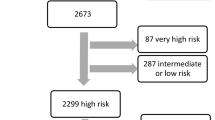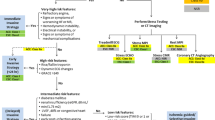Abstract
Purpose of Review
We assessed the differences in the 2020 European Society of Cardiology (ESC) versus 2015 ESC and 2014 American College of Cardiology (ACC) guidelines on the management of non-ST-segment elevation acute coronary syndromes (NSTE-ACS).
Recent Findings
The recent publication of the 2020 ESC has provided a comprehensive series of recommendations on diagnosis and management of patients presenting with NSTE-ACS. However, there are discrepancies between the 2020 ESC versus 2015 ESC and 2014 ACC guidelines, creating uncertainty among clinicians in routine practices. Our investigation provides insights into several domains, including diagnosis, risk stratification, pharmacological treatments, invasive treatment, and special populations.
Summary
Overall, it seems that the 2020 version of the ESC guideline for the management of NSTE-ACS provides the most evidence-based recommendations for clinicians; although due to the lack of validated investigation across some of the proposed recommendations, further longitudinal multicenter studies are warranted to address the current questions.
Graphical abstract
Diagnostic algorithm in NSTE-ACS. Abbreviations: ACC = American College of Cardiology; CABG = coronary artery bypass grafting; CCTA = coronary computed tomography angiography; CMR = cardiac magnetic resonance; CS = cardiogenic shock; ECG = electrocardiography; eGFR = estimated glomerular filtration rate; ESC = European Society of Cardiology; GRACE = Global Registry of Acute Coronary Events; HF = heart failure; LVEF = left ventricular ejection fraction; MPI = myocardial perfusion imaging; MR = mitral regurgitation; NSTE-ACS = non-ST-segment elevation acute coronary syndromes; PCI = percutaneous coronary intervention; TIMI = thrombolysis in myocardial infarction


Similar content being viewed by others
References
Papers of particular interest, published recently, have been highlighted as: • Of importance •• Of major importance
Global, regional, and national age-sex-specific mortality for 282 causes of death in 195 countries and territories, 1980–2017: a systematic analysis for the Global Burden of Disease Study 2017. Lancet (London, England). 2018;392(10159):1736–88. doi:https://doi.org/10.1016/s0140-6736(18)32203-7.
GBD Compare. Institute for Health Metrics and Evaluation. https://vizhub.healthdata.org/gbd-compare/. Accessed February 6 2021.
Roth GA, Mensah GA, Johnson CO, Addolorato G, Ammirati E, Baddour LM, et al. Global burden of cardiovascular diseases and risk factors, 1990–2019: update from the GBD 2019 study. J Am Coll Cardiol. 2020;76(25):2982–3021. https://doi.org/10.1016/j.jacc.2020.11.010.
Knuuti J, Wijns W, Saraste A, Capodanno D, Barbato E, Funck-Brentano C, et al. 2019 ESC Guidelines for the diagnosis and management of chronic coronary syndromes. Eur Heart J. 2020;41(3):407–77. https://doi.org/10.1093/eurheartj/ehz425.
•• Collet JP, Thiele H, Barbato E, Barthélémy O, Bauersachs J, Bhatt DL et al. 2020 ESC Guidelines for the management of acute coronary syndromes in patients presenting without persistent ST-segment elevation. European heart journal. 2020. https://doi.org/10.1093/eurheartj/ehaa575. The 2020 ESC guideline for the management of NSTE-ACS provides the most evidence-based recommendations for clinicians on how to accurately diagnose and manage these groups of patients.
•• Roffi M, Patrono C, Collet JP, Mueller C, Valgimigli M, Andreotti F et al. 2015 ESC Guidelines for the management of acute coronary syndromes in patients presenting without persistent ST-segment elevation: Task Force for the Management of Acute Coronary Syndromes in Patients Presenting without Persistent ST-Segment Elevation of the European Society of Cardiology (ESC). European heart journal. 2016;37(3):267-315. https://doi.org/10.1093/eurheartj/ehv320. Comparing the results of this study (2015 ESC) with the 2020 ESC guideline for the management of patients with NSTE-ACS could provide critical insights about the latest updates in the management of NSTE-ACS.
•• Amsterdam EA, Wenger NK, Brindis RG, Casey DE, Jr., Ganiats TG, Holmes DR, Jr. et al. 2014 AHA/ACC Guideline for the Management of Patients with Non-ST-Elevation Acute Coronary Syndromes: a report of the American College of Cardiology/American Heart Association Task Force on Practice Guidelines. Journal of the American College of Cardiology. 2014;64(24):e139-e228. https://doi.org/10.1016/j.jacc.2014.09.017. Comparing the findings of this study (2014 ACC) with the 2020 ESC guideline for the management of patients with NSTE-ACS could pave the way for better understanding the latest insights for these group of patients.
Smulders MW, Kietselaer B, Wildberger JE, Dagnelie PC, Brunner-La Rocca HP, Mingels AMA, et al. Initial imaging-guided strategy versus routine care in patients with non-ST-segment elevation myocardial infarction. J Am Coll Cardiol. 2019;74(20):2466–77. https://doi.org/10.1016/j.jacc.2019.09.027.
Linde JJ, Kelbæk H, Hansen TF, Sigvardsen PE, Torp-Pedersen C, Bech J, et al. Coronary CT angiography in patients with non-ST-segment elevation acute coronary syndrome. J Am Coll Cardiol. 2020;75(5):453–63. https://doi.org/10.1016/j.jacc.2019.12.012.
Chew DP, Astley CM, Luker H, Alprandi-Costa B, Hillis G, Chow CK, et al. A cluster randomized trial of objective risk assessment versus standard care for acute coronary syndromes: rationale and design of the Australian GRACE Risk score Intervention Study (AGRIS). Am Heart J. 2015;170(5):995-1004.e1. https://doi.org/10.1016/j.ahj.2015.07.032.
Urban P, Mehran R, Colleran R, Angiolillo DJ, Byrne RA, Capodanno D, et al. Defining high bleeding risk in patients undergoing percutaneous coronary intervention: a consensus document from the Academic Research Consortium for High Bleeding Risk. Eur Heart J. 2019;40(31):2632–53. https://doi.org/10.1093/eurheartj/ehz372.
Yeh RW, Secemsky EA, Kereiakes DJ, Normand SL, Gershlick AH, Cohen DJ, et al. Development and validation of a prediction rule for benefit and harm of dual antiplatelet therapy beyond 1 year after percutaneous coronary intervention. JAMA. 2016;315(16):1735–49. https://doi.org/10.1001/jama.2016.3775.
• Costa F, van Klaveren D, James S, Heg D, Räber L, Feres F et al. Derivation and validation of the predicting bleeding complications in patients undergoing stent implantation and subsequent dual antiplatelet therapy (PRECISE-DAPT) score: a pooled analysis of individual-patient datasets from clinical trials. Lancet (London, England). 2017;389(10073):1025-34. doi:https://doi.org/10.1016/s0140-6736(17)30397-5. This study revealed that the PRECISE-DAPT score could provide a robust tool for the prediction of out-of-hospital bleeding during DAPT in patients with NSTE-ACS.
•Schüpke S, Neumann FJ, Menichelli M, Mayer K, Bernlochner I, Wöhrle J et al. Ticagrelor or prasugrel in patients with acute coronary syndromes. The New England journal of medicine. 2019;381(16):1524–34. https://doi.org/10.1056/NEJMoa1908973. Findings of this study indicated that the administration of prasugrel is preferred over ticagrelor in the pre-treatment of patients with NSTE-ACS.
Montalescot G, Bolognese L, Dudek D, Goldstein P, Hamm C, Tanguay JF, et al. Pretreatment with prasugrel in non-ST-segment elevation acute coronary syndromes. N Engl J Med. 2013;369(11):999–1010. https://doi.org/10.1056/NEJMoa1308075.
• Dworeck C, Redfors B, Angerås O, Haraldsson I, Odenstedt J, Ioanes D et al. Association of pretreatment with P2Y12 receptor antagonists preceding percutaneous coronary intervention in non-ST-segment elevation acute coronary syndromes with outcomes. JAMA network open. 2020;3(10):e2018735. https://doi.org/10.1001/jamanetworkopen.2020.18735. The ACCOAST study demonstrated no association between prasugrel pre-treatment and ischemic benefit, but inversely, with notably higher bleeding risk in patients with NSTE-ACS.
Mauri L, Kereiakes DJ, Yeh RW, Driscoll-Shempp P, Cutlip DE, Steg PG, et al. Twelve or 30 months of dual antiplatelet therapy after drug-eluting stents. N Engl J Med. 2014;371(23):2155–66. https://doi.org/10.1056/NEJMoa1409312.
Bonaca MP, Bhatt DL, Cohen M, Steg PG, Storey RF, Jensen EC, et al. Long-term use of ticagrelor in patients with prior myocardial infarction. N Engl J Med. 2015;372(19):1791–800. https://doi.org/10.1056/NEJMoa1500857.
• Eikelboom JW, Connolly SJ, Bosch J, Dagenais GR, Hart RG, Shestakovska O et al. Rivaroxaban with or without aspirin in stable cardiovascular disease. The New England journal of medicine. 2017;377(14):1319-30. https://doi.org/10.1056/NEJMoa1709118. This study represented either rivaroxaban, ticagrelor, or prasugrel could be applied for post-interventional and maintenance treatment in NSTE-ACS patients at high risk of ischemic events and without increased HBR.
Yasuda S, Kaikita K, Akao M, Ako J, Matoba T, Nakamura M, et al. Antithrombotic therapy for atrial fibrillation with stable coronary disease. N Engl J Med. 2019;381(12):1103–13. https://doi.org/10.1056/NEJMoa1904143.
Han Y, Guo J, Zheng Y, Zang H, Su X, Wang Y, et al. Bivalirudin vs heparin with or without tirofiban during primary percutaneous coronary intervention in acute myocardial infarction: the BRIGHT randomized clinical trial. JAMA. 2015;313(13):1336–46. https://doi.org/10.1001/jama.2015.2323.
Nührenberg TG, Hochholzer W, Mashayekhi K, Ferenc M, Neumann FJ. Efficacy and safety of bivalirudin for percutaneous coronary intervention in acute coronary syndromes: a meta-analysis of randomized-controlled trials. Clin Res Cardiol. 2018;107(9):807–15. https://doi.org/10.1007/s00392-018-1251-1.
Bonello L, Laine M, Puymirat E, Lemesle G, Thuny F, Paganelli F, et al. Timing of coronary invasive strategy in non-ST-segment elevation acute coronary syndromes and clinical outcomes: an updated meta-analysis. JACC Cardiovasc Interv. 2016;9(22):2267–76. https://doi.org/10.1016/j.jcin.2016.09.017.
Rathod KS, Koganti S, Jain AK, Astroulakis Z, Lim P, Rakhit R, et al. Complete versus culprit-only lesion intervention in patients with acute coronary syndromes. J Am Coll Cardiol. 2018;72(17):1989–99. https://doi.org/10.1016/j.jacc.2018.07.089.
Sardella G, Lucisano L, Garbo R, Pennacchi M, Cavallo E, Stio RE, et al. Single-staged compared with multi-staged PCI in multivessel NSTEMI patients: the SMILE trial. J Am Coll Cardiol. 2016;67(3):264–72. https://doi.org/10.1016/j.jacc.2015.10.082.
Layland J, Oldroyd KG, Curzen N, Sood A, Balachandran K, Das R, et al. Fractional flow reserve vs. angiography in guiding management to optimize outcomes in non-ST-segment elevation myocardial infarction: the British Heart Foundation FAMOUS-NSTEMI randomized trial. Eur Heart J. 2015;36(2):100–11. https://doi.org/10.1093/eurheartj/ehu338.
Author information
Authors and Affiliations
Contributions
MM: original draft preparation, conceptualization, methodology, investigation. HA: original draft preparation, conceptualization, methodology, investigation. SR: original draft preparation, conceptualization, methodology, investigation. HF: original draft preparation, conceptualization, methodology, investigation. BH: review and editing, investigation, data curation. SZ: review and editing, investigation, data curation. SB: review and editing, investigation, data curation. RF: review and editing, investigation, data curation. SA: review and editing, investigation, data curation. AA: review and editing, investigation, data curation. SKS*: review and editing, conceptualization, methodology, supervision. SJ*: review and editing, conceptualization, methodology, supervision. All authors read and approved the final manuscript. *Corresponding authors.
Corresponding authors
Ethics declarations
Conflict of Interest
The authors declare that they have no conflict of interest.
Human and Animal Rights
This article does not contain any studies with human or animal subjects performed by any of the authors.
Informed Consent
Not applicable.
Additional information
Publisher's Note
Springer Nature remains neutral with regard to jurisdictional claims in published maps and institutional affiliations.
This article is part of the Topical Collection on Evidence-Based Medicine, Clinical Trials and Their Interpretation
Supplementary Information
Below is the link to the electronic supplementary material.
Rights and permissions
About this article
Cite this article
Keykhaei, M., Ashraf, H., Rashedi, S. et al. Differences in the 2020 ESC Versus 2015 ESC and 2014 ACC/AHA Guidelines on the Management of Acute Coronary Syndromes in Patients Presenting Without Persistent ST-Segment Elevation. Curr Atheroscler Rep 23, 77 (2021). https://doi.org/10.1007/s11883-021-00976-7
Accepted:
Published:
DOI: https://doi.org/10.1007/s11883-021-00976-7




